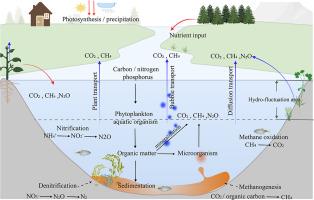当前位置:
X-MOL 学术
›
Water Res.
›
论文详情
Our official English website, www.x-mol.net, welcomes your
feedback! (Note: you will need to create a separate account there.)
Global inland water greenhouse gas (GHG) geographical patterns and escape mechanisms under different water level
Water Research ( IF 11.4 ) Pub Date : 2024-11-17 , DOI: 10.1016/j.watres.2024.122808 Yang Gao, Jiajia Li, Shuoyue Wang, Junjie Jia, Fan Wu, Guirui Yu
Water Research ( IF 11.4 ) Pub Date : 2024-11-17 , DOI: 10.1016/j.watres.2024.122808 Yang Gao, Jiajia Li, Shuoyue Wang, Junjie Jia, Fan Wu, Guirui Yu

|
Inland water ecosystems are unique, whereby water level changes can lead to variance in greenhouse gas (GHG) emissions. The GHG circulation intensity of inland waterbodies is high, so different water depths affect the temperature sensitivity of greenhouse gases, and have different cooling effects on CO2 storage and warming effects on CH4 emissions, being a typical GHG conversion channel. This study systematically reveals geographical GHG emission patterns from inland waterbodies and GHG impact mechanisms from regional waterbodies. Special emphasis is also paid to compounded environmental impact changes on GHG emissions under water level regulations. Additionally, we explore how increases in primary productivity can convert aquatic ecosystems from CO2 sources to CO2 sinks. However, GHG formation and emissions under ecological reservoir water level fluctuations in flood-ebb zones, intertidal tidal zones, wetlands, and lacustrine systems remain uncertain compared with those under natural hydrological conditions. Therefore, mechanisms that control GHG exchange and production processes under water level changes must first be determined, especially regarding post flood hydrological-based drying effects on GHG flux at the water-air interface. Finally, we recommend instituting environmental management and water-level control measures to reduce GHG emissions, which are favorable for minimizing GHG flux while protecting ecosystem functions and biodiversity.
中文翻译:

全球内陆水域温室气体 (GHG) 地理格局及不同水位下的逃逸机制
内陆水域生态系统是独一无二的,水位变化会导致温室气体 (GHG) 排放的变化。内陆水体温室气体循环强度高,因此不同的水深会影响温室气体的温度敏感性,对CO2 储存的冷却作用和对 CH4 排放的变暖作用不同,是典型的 GHG 转换通道。本研究系统揭示了内陆水体的地理温室气体排放模式和区域水体的 GHG 影响机制。还特别强调了水位法规下温室气体排放的复合环境影响变化。此外,我们还探讨了初级生产力的提高如何将水生生态系统从 CO2 源转化为 CO2 汇。然而,与自然水文条件下相比,洪水退潮带、潮间带、湿地和湖泊系统在生态库水位波动下的温室气体形成和排放仍不具有不确定性。因此,必须首先确定在水位变化下控制温室气体交换和生产过程的机制,特别是关于洪水后基于水文的干燥对水-空气界面温室气体通量的影响。最后,我们建议制定环境管理和水位控制措施来减少温室气体排放,这有利于最大限度地减少温室气体通量,同时保护生态系统功能和生物多样性。
更新日期:2024-11-18
中文翻译:

全球内陆水域温室气体 (GHG) 地理格局及不同水位下的逃逸机制
内陆水域生态系统是独一无二的,水位变化会导致温室气体 (GHG) 排放的变化。内陆水体温室气体循环强度高,因此不同的水深会影响温室气体的温度敏感性,对CO2 储存的冷却作用和对 CH4 排放的变暖作用不同,是典型的 GHG 转换通道。本研究系统揭示了内陆水体的地理温室气体排放模式和区域水体的 GHG 影响机制。还特别强调了水位法规下温室气体排放的复合环境影响变化。此外,我们还探讨了初级生产力的提高如何将水生生态系统从 CO2 源转化为 CO2 汇。然而,与自然水文条件下相比,洪水退潮带、潮间带、湿地和湖泊系统在生态库水位波动下的温室气体形成和排放仍不具有不确定性。因此,必须首先确定在水位变化下控制温室气体交换和生产过程的机制,特别是关于洪水后基于水文的干燥对水-空气界面温室气体通量的影响。最后,我们建议制定环境管理和水位控制措施来减少温室气体排放,这有利于最大限度地减少温室气体通量,同时保护生态系统功能和生物多样性。


















































 京公网安备 11010802027423号
京公网安备 11010802027423号